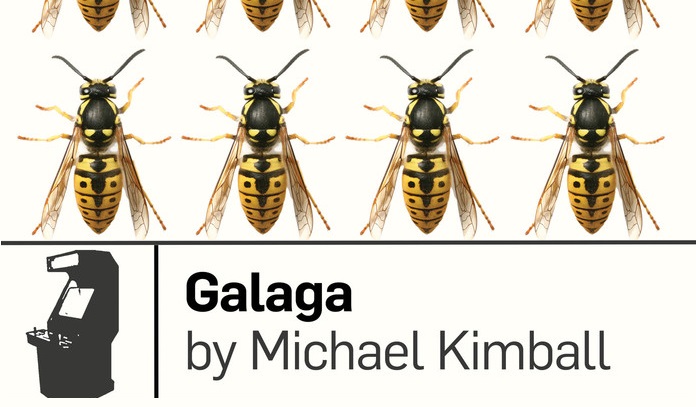Boss Fight Books’ “Galaga” By Michael Kimball – Reviewed
By Marcus Estrada
[divider] [dropcap]I[/dropcap]f you were around for the arcade game craze in the 20th century then you’re likely very familiar with a ton of the space-based games. Space Invaders, Asteroids, Galaxian, Defender, Galaga, and others all captured an exciting atmosphere that you could experience for a single quarter. It is Galaga which serves the focus of the latest Boss Fight Books title, aptly named Galaga. Author Michael Kimball spends some 130 pages covering every facet of Galaga while also delving into his own life.
[dropcap]I[/dropcap]f you were around for the arcade game craze in the 20th century then you’re likely very familiar with a ton of the space-based games. Space Invaders, Asteroids, Galaxian, Defender, Galaga, and others all captured an exciting atmosphere that you could experience for a single quarter. It is Galaga which serves the focus of the latest Boss Fight Books title, aptly named Galaga. Author Michael Kimball spends some 130 pages covering every facet of Galaga while also delving into his own life.
After all, without much of a defined story, how much can one really say about Galaga? Yes, Michael covers all the basics about the game’s launch, mechanics, and lasting legacy. Hell, it even delves into discussion of more complex gameplay tips that a novice like me can understand but hardly put into practice. But then there are the parts where he discusses his youth to explain this childhood obsession. These are the hardest to read because of their innately personal nature.
 Anyone looking to read Galaga needs to be aware of possibly triggering content within its pages. Memories of child abuse are visited on multiple occasions which is not something that someone reading a book about an arcade game probably expects. With that said, the Boss Fight Books line appears to embrace books that are both encyclopedic and personal narratives/explorations. These segments have a point and help to explain the importance of Galaga to one man – Michael. Because of this, the game takes on greater impact for readers as well.
Anyone looking to read Galaga needs to be aware of possibly triggering content within its pages. Memories of child abuse are visited on multiple occasions which is not something that someone reading a book about an arcade game probably expects. With that said, the Boss Fight Books line appears to embrace books that are both encyclopedic and personal narratives/explorations. These segments have a point and help to explain the importance of Galaga to one man – Michael. Because of this, the game takes on greater impact for readers as well.
That’s not to say every framing decision of the book is for the better. Every so often a list of official and fan-created Galaga merchandise is described. It seems that just a few examples of the obvious stuff (shirts, key chains, hats) would be enough alongside a few more unusual items. It doesn’t take many pages to show how devoted fans are to the game, but that’s exactly what happens here. This is most likely due to the book’s framing, which is set up to have 255 “chapters” since Galaga has 255 stages. With that said, enough very interesting segments exist to make the issue fairly minor.
 On one hand Galaga is an uncomfortable read but on the other hand it is an extremely brave piece of work. It’s hard not to be amazed by Michael’s willingness to put a slice of his life on display in order to show why Galaga is an important game. Many modern gamers may not have ever even played it but his utter devotion to the topic shows. Those who’ve yet to play an arcade game may be spurred to seek one out. For those with memories of arcade classics, reading Galaga should bring about the urge to play a few rounds for old times’ sake.
On one hand Galaga is an uncomfortable read but on the other hand it is an extremely brave piece of work. It’s hard not to be amazed by Michael’s willingness to put a slice of his life on display in order to show why Galaga is an important game. Many modern gamers may not have ever even played it but his utter devotion to the topic shows. Those who’ve yet to play an arcade game may be spurred to seek one out. For those with memories of arcade classics, reading Galaga should bring about the urge to play a few rounds for old times’ sake.
[Google][pinterest][follow id=”Cliqist” size=”large” count=”true” ] [author image=”http://cliqist.com/wp-content/uploads/2014/01/marcus.jpg” ]Marcus is a fellow with a love for video games, horror, and Japanese food. When he’s not writing about games for a multitude of sites, he’s usually still playing one. One day when he became fed up with the way sites would ignore niche titles he decided to start his own site by the name of Pixel Pacas. Writing about video games is something he hopes to continue doing for many years to come. Some of Marcus’s favorite games include Silent Hill 2, Killer7, and The Sims. [/author]




